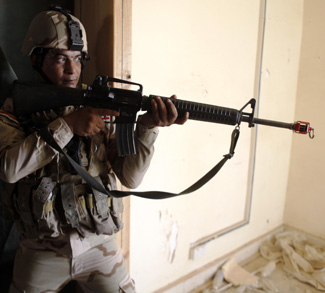Summary
An intra-Shiite power struggle is underway as cleric Muqtada al-Sadr attempts to maintain control over his militia (the Jaysh al-Mahdi, JAM) and transform it into a legitimate political movement. He faces thee major obstacles: the governing coalition headed by Prime Minister Nuri Al-Maliki, which seeks to marginalize the JAM, Iran’s desire to control elements of the JAM as proxies, and a confused and uncertain American position.
Analysis
Recent statements by al-Sadr and Sadrist leaders in Baghdad reflect a shift in strategy: al-Sadr seeks to leverage his power base (a militia risen from destitute Shiite slums in Baghdad) and become a legitimate political player in Iraq’s national politics. Hence, in a March 2008 interview with Al-Jazeera and a subsequent statement, al-Sadr identified “sit-ins” and “civil methods” as crucial tools of the JAM.
In response, the governing coalition (United Iraqi Alliance, UIA) headed by al-Maliki, which incorporates the two other most powerful Shiite blocs – the Islamic Supreme Council in Iraq and the Islamic Dawa Party – has attempted to provoke and marginalize al-Sadr, so as to avoid ceding any political power. This is most recently evidenced by the government’s unusually fierce raids against Sadrists in Karbala and Basra, whereupon skirmishing spread to Baghdad.
The UIA’s attacks have bedevilled al-Sadr’s efforts to transform the JAM. Unwilling to forgo retaliation, radical splinter factions have emerged, which are funded and trained by Iran. Iran benefits from such Iraqi proxies, using them as leverage against American-led action against Hizbullah and the Iranian nuclear program.
The American strategic position vis a vis al-Sadr is marked by ambiguity and ambivalence, and is likely to change reactively to a fluid situation. Thus far, American forces have provided military support and de facto political support to the UIA’s assaults against the JAM. However, recent statements by mid-ranking American military commanders have omitted any mention of al-Sadr or the JAM as enemies, and thus suggest that the American strategy is to wait and see. If it helps consolidate the gains of the “surge” and reduces Iranian influence, Americans would accept al-Sadr’s legitimization and inclusion in the Iraqi government.
Brief Biography: Muqtada al-Sadr
Thirty-five year old Muqtada al-Sadr is the fourth son of deceased Iraqi Shia cleric (executed by the former Baathist regime in 1999), the Grand Ayatollah Mohammad Muhammed Sadeq al-Sadr. Soon after the 2003 invasion of Iraq, Muqtada al-Sadr positioned himself as a populist, nationalist, Islamist leader with a power base of primarily poor, urban Shiites residing in “Sadr City”, a sprawling Baghdad slum. After leading the JAM for five years against the nascent Iraqi government and occupation forces, al-Sadr left Iraq in 2007 to study in Qom, Iran to earn the religious title of Ayatollah. Around the same time, al-Sadr agreed to a ceasefire, and most observers agree this contributed to the success of the American “surge”. Al-Sadr remains secluded in Qom for the time being, though he has increased his profile of late.
Ian Speigel is a contributor to Geopoliticalmonitor.com



